Cite this document
(Issues at the Management of Academic Libraries Coursework, n.d.)
Issues at the Management of Academic Libraries Coursework. Retrieved from https://studentshare.org/management/1430024-sm2037-customer-service-operations-and-excellence
Issues at the Management of Academic Libraries Coursework. Retrieved from https://studentshare.org/management/1430024-sm2037-customer-service-operations-and-excellence
(Issues at the Management of Academic Libraries Coursework)
Issues at the Management of Academic Libraries Coursework. https://studentshare.org/management/1430024-sm2037-customer-service-operations-and-excellence.
Issues at the Management of Academic Libraries Coursework. https://studentshare.org/management/1430024-sm2037-customer-service-operations-and-excellence.
“Issues at the Management of Academic Libraries Coursework”, n.d. https://studentshare.org/management/1430024-sm2037-customer-service-operations-and-excellence.


